<< Previous | Displaying results 1051-1075 of 1298 for "nazi germany" | Next >>
Istvan was born to a Jewish family in the small agricultural city of Torokszentmiklos, about 65 miles from Budapest. Istvan worked for the Hungarian railroads during World War I, and afterwards earned a degree in pharmacology. In the 1920s Istvan married Barbara Nemeth and they settled in Torokszentmiklos. In 1929 the couple had a son, Janos. 1933-39: During the early 1930s, after the onset of the Depression, Istvan helped his father in the family's grain exporting business. In 1933 Istvan and Barbara…
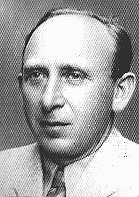
Ilona was one of seven children born to a Jewish family in the city of Szeged, about 100 miles south of Budapest. Her father was an accountant. At the turn of the century many of Ilona's father's relatives emigrated to the United States, but Ilona's father decided to stay. Ilona also became an accountant and got a job in Szeged. 1933-39: Ilona's work as an accountant kept her busy but her free time was spent enjoying music and sports. She also began to study English since so many of her relatives had…
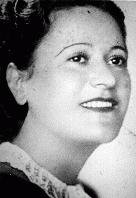
Robert was raised in a German-speaking Jewish family in the Slovakian capital of Bratislava, where his father owned a dental supply business. Robert grew up bilingual: He learned Hungarian from his mother and he attended a German-language Jewish grammar school. 1933-39: When Hitler rose to power in Germany, anti-German sentiment grew in Slovakia and many Jews in Bratislava, like Robert's parents, who had originally identified with German culture, enrolled their children in Slovak schools. In March 1939…

Josef was born to Yiddish-speaking, religious Jewish parents in the town of Viseu de Sus in Transylvania, a region of Romania that belonged to Hungary until 1918. In 1890 he married Emma Geisler from the nearby town of Bistrita. The couple had four children and after 1910 the family lived at #4 Hid Street in Viseu de Sus. Josef was a merchant who owned a stall in Viseu de Sus's public market. 1933-39: By 1939 two of Josef's grown sons had moved to the Hungarian capital of Budapest. Josef and his wife…
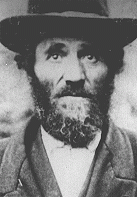
Chava Lea was born Emma Geisler to Yiddish-speaking, religious Jewish parents. The Deutsch family lived in the village of Budacu de Sus in Transylvania, a region of Romania that belonged to Hungary until 1918. She grew up in the town of Bistrita. In 1890 she married Josef Deutsch, a salesman from the town of Viseu de Sus, where the couple moved in 1910. Chava and Josef raised four children. 1933-39: By 1939 two of Chava Lea's grown sons had moved to the Hungarian capital of Budapest. Chava Lea and her…
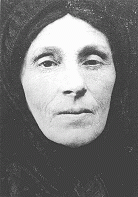
Learn about the voyages of the ships Orduña, Flandre, and Orinoco in May 1939, carrying Jewish refugees fleeing Nazi Germany and seeking safety in Cuba.
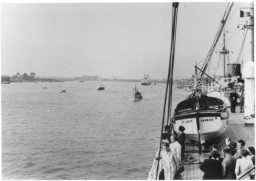
In 1940, the Nazis established Lublin (Majdanek) concentration camp in Lublin, Poland. Learn more about camp administration.
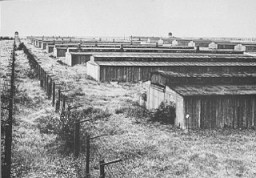
German forces occupied Riga, Latvia in July 1941. Learn more about the establishment of the Riga ghetto, mass shootings of Jews, and Jewish resistance.
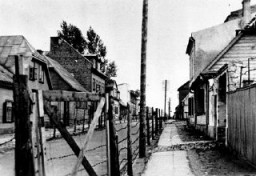
On March 11, 1943, over 3,000 of Monastir’s Jews were deported to Treblinka. Learn more about the history of the community and postwar memorialization.
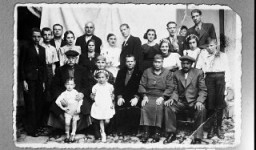
Learn about conditions in the Sachsenhausen concentration camp system and the treatment of prisoners there, including medical experiments and forced labor.
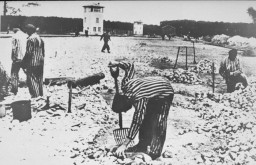
June 12, 1929. On this date, future diarist Anne Frank was born to Otto and Edith Frank. She would become a symbol for the children who died in the Holocaust.

Field Marshal Wilhelm Keitel was commander of all German armed forces during World War II. Learn about his military career and postwar trial.
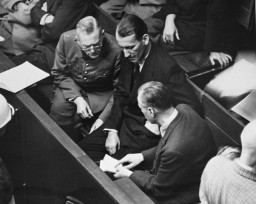
Learn more about the efforts of L.P.J. de Decker, Jan Zwartendijk, and Chiune Sugihara to help Polish Jewish refugees escape Lithuania during the war.
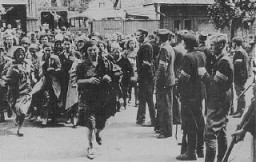
György Beifeld, a Jewish conscript in the Hungarian army, created a visual memoir of his experiences on the eastern front in 1942–1943 as a member of a forced-labor battalion .
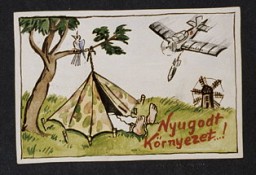
On May 25, 1939, artist Moritz Schoenberger sent this radiogram (a telegram sent by radio) from the ocean liner "St. Louis" during the voyage from Hamburg, Germany, to Havana, Cuba. On this voyage, the "St. Louis" carried over 900 Jewish refugees fleeing Nazi persecution. The telegram reads, in part, "Physically and spiritually recovered and invigorated most confident about reaching Havana Saturday. Money received. Many thanks. Kisses. Papa." Schoenberger's optimism proved unfounded. Cuban authorities…
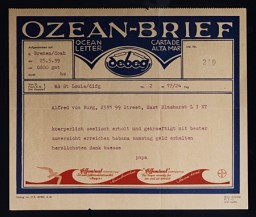
Seward Daily Gateway (Alaska) article from April 14, 1933, titled "Great Bonfires of Forbidden Books in Germany to Blaze." This article from Berlin, written the month before the book burnings took place, reported that "Great bonfires will be burning on the campus of German universities in a few days, when the latest Nazi decree goes into effect. The Hitler regime is continuing its nationalistic crusade, has ordered that all books which deal with non-German subjects or espouse non-German causes, must be…
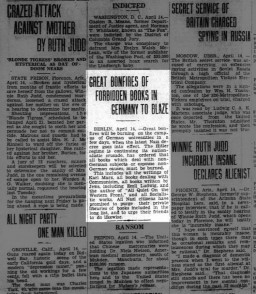
Ion Antonescu governed Romania from 1940 until 1944. Antonescu aligned Romania with the Axis powers in November 1940, and became one of Nazi Germany's closest allies. Romania joined in the German invasion of the Soviet Union in 1941. It also implemented harsh anti-Jewish policies against Jews in Romania. While Antonescu ultimately refused to hand Jews over to the Germans, Romanian forces brutally killed hundreds of thousands of Jews, mainly residents of Bessarabia, Bukovina, and the western Ukraine. As the…
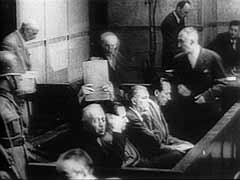
Allied air superiority over Germany was a decisive factor in the success of the D-Day (June 6, 1944) landings in France. This footage shows the Allied bombing of suspected German positions during the battle. Allied air attacks both supported Allied ground operations in Normandy and prevented German reinforcements from reaching the area. The Allies would liberate most of France by the end of August 1944.
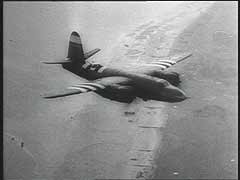
Drexel Sprecher was educated at the University of Wisconsin, the London School of Economics, and at the Harvard School of Law before receiving a position at the US Government's Labor Board in 1938. He enlisted in the American military after the United States declared war on Germany, and was posted to London. After the war, Sprecher served as a prosecutor of Nazi war criminals at the Nuremberg trials.
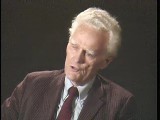
Drexel Sprecher was educated at the University of Wisconsin, the London School of Economics, and at the Harvard School of Law before receiving a position at the US Government's Labor Board in 1938. He enlisted in the American military after the United States declared war on Germany, and was posted to London. After the war, Sprecher served as a prosecutor of Nazi war criminals at the Nuremberg trials.

Former prisoners of the "little camp" in Buchenwald stare out from the wooden bunks in which they slept three to a "bed." Elie Wiesel is pictured in the second row of bunks, seventh from the left, next to the vertical beam. Abraham Hipler is pictured in the second row, fourth from the left. The man on the third bunk from the bottom, third from the left, is Ignacz (Isaac) Berkovicz. [He has also been identified as Abraham Baruch.] Michael Nikolas Gruner, originally from Hungary, is pictured on the bottom…
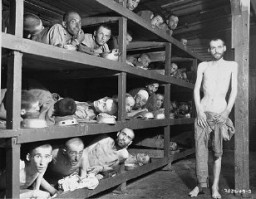
The plight of German-Jewish refugees, persecuted at home and unwanted abroad, is illustrated by the voyage of the SS "St. Louis." On May 13, 1939, the SS "St. Louis," a German ocean liner, left Germany with almost a thousand Jewish refugees on board. The refugees' destination was Cuba, but before their arrival the Cuban government revoked their permission to land. The "St. Louis" was forced to return to Europe in June 1939. However, Great Britain, France, Belgium, and the Netherlands agreed to accept the…

Members of a resistance organization in the camp meet with American soldiers in front of the entrance to the Buchenwald concentration camp. Buchenwald, Germany, after April 11, 1945. In early April 1945, as US forces approached the camp, the Germans began to evacuate some 28,000 prisoners from the main camp and an additional several thousand prisoners from the subcamps of Buchenwald. About a third of these prisoners died from exhaustion en route or shortly after arrival, or were shot by the SS. The…
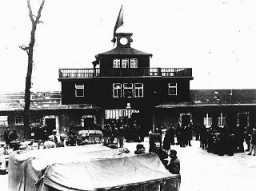
Photograph from a series taken by a guard in the Soviet prisoner-of-war camp of Belzen bei Bergen, and numbered in Roman numerals by the American officer, Lt. van Otten. The camp held approximately 10,000 POWs, most of whom came from Fallingbostel, 10 km away. When they fell ill, they were marched to Belsen. At Belsen, they were starved, often given only a soup made of field beets. This photo shows Soviet POWs assembled at the camp. Germany, 1941–45. Second only to the Jews, Soviet prisoners of war…
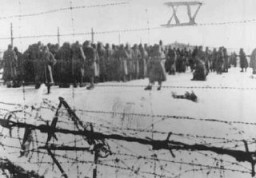
In July 1942, Anne Frank and her family went into hiding in Amsterdam until they were discovered and deported in 1944. View a map showing key locations.

We would like to thank Crown Family Philanthropies, Abe and Ida Cooper Foundation, the Claims Conference, EVZ, and BMF for supporting the ongoing work to create content and resources for the Holocaust Encyclopedia. View the list of donor acknowledgement.